Your Favorite Image?
Which of today’s three featured square images do you like best? All are invited to leave a comment and let us know why they made their choice.
What’s Up?
I met Anar early on Tuesday morning. We began by working on her a1 set-up; she was in pretty good shape. Because she has small hands, she likes the ISO on the index finger wheel rather than on the thumb dial. As I had showed her a few pleasing blurs from my Sunday visit, she was anxious to get started. Because we can get lots of green in the background when doing blurs at Stick Marsh, it is best to work in Manual mode. I taught her to get the right exposure by adding 1 2/3 stops to the meter reading off the still, gray water. We had non-stop action for well more than an hour, but when it got brighter, things slowed down. She learned so much in such a short time and had so much fun that she is coming back for a second session on Thursday.
After brunch at home, I got my nap, did my bursts, and enjoyed a sunny afternoon swim. Today is Wednesday 4 May 2022. The morning forecast for ILE is for partly cloudy with almost no wind. I will head down to the lake for a short session. Wherever you are and whatever you are doing, I hope that you too have a great day. This blog post took about 90 minutes to prepare and makes fifty-four days in a row with a new one.
Please remember to use the B&H and Amazon links that are found on most blog pages and to use the BIRDSASART discount code at checkout when purchasing your new gear from Bedfords. Please, also, consider joining a BAA IPT. You will be amazed at how much you will learn!
|
|
|
Click on the composite image to enjoy the incredible quality of the hi-res JPEG. Clockwise from upper left back around to the center: spoonbill with mangrove background; spoonbill head and shoulders portrait; spoonbill braking to land; spoonbill dramatic landing pose; adult Black-crowned Night-Heron; spoonbill with nesting material; Great Egret returning to nest; incoming spoonbill; and Limpkin landing. |
Stick Marsh In-the-Field Sessions
6:30 to 9:00am: $250.00/person
Two 1/2 hours of intensive flight photography instruction: $250/person. Cheap! If you are interested, please contact me ASAP via e-mail and we can set up a session or two based on the weather forecast. The weather is looking fine for this Thursday and for next Monday and Tuesday. I am not sure how long the action will last, so the sooner the better.
BIRDS AS ART Image Optimization Service (BAA IOS)
Send a PayPal for $62.00 to birdsasart@verizon.net or call Jim at 863-692-0906 and put $62.00 on your credit card. Pick one of your best images and upload the raw file using a large file sending service like Hightail or DropBox and then send me the link via e-mail. I will download and save your raw file, evaluate the exposure and sharpness, and optimize the image as if it were my own after converting the raw file in Adobe Camera Raw. Best of all, I will make a screen recording of the entire process and send you a link to the video to download, save and study.
Just for the Record
If you are not using a Sony a1 for bird photography, you are making your life far more difficult than it needs to be. Period. If you would like to receive a short but frank e-mail explaining why the Sony a1 is so much better than the best Nikon and Canon mirrorless camera bodies, please click here.
And Please Remember
You can find some great photo accessories (and necessities, like surf booties!) on Amazon by clicking on the Stuff tab on the orange/yellow menu bar above. On a related note, it would be extremely helpful if blog-folks who, like me, spend too much money on Amazon, would get in the habit of clicking on the Amazon logo link on the right side of each blog post when they shop online. As you might expect, doing so will not cost you a single penny, but would be appreciated tremendously by yours truly. And doing so works seamlessly with your Amazon Prime account.
Please remember that if an item — a Delkin flash card, or a tripod head — for example, that is available from B&H and/or Bedfords, is also available in the BAA Online Store, it would be great, and greatly appreciated, if you would opt to purchase from us. We will match any price. Please remember also to use my B&H affiliate links or to earn 3% cash back at Bedfords by using the BIRDSASART discount code at checkout for your major gear purchases. Doing either often earns you free guides and/or discounts. And always earns my great appreciation.
Brand-New and As-Good-As-Ever Bedfords BAA Discount Policy
Folks who have fallen in love with Bedfords can now use the BIRDSASART coupon code at checkout to enjoy a post-purchase, 3% off-statement credit (excluding taxes and shipping charges) on orders paid with a credit card. The 3% credit will be refunded to the card you used for your purchase. Be sure, also, to check the box for free shipping to enjoy free Second Day Air Fed-Ex. This offer does not apply to purchases of Classes, Gift Cards, or to any prior purchases.
Money Saving Reminder
Many have learned that if you need a hot photo item that is out of stock at B&H and would like to enjoy getting 3% back on your credit card along with free 2nd Day Air Fed-Ex Air shipping, your best bet is to click here, place an order with Bedfords, and enter the coupon code BIRDSASART at checkout. If an item is out of stock, contact Steve Elkins via e-mail or on his cell phone at (479) 381-2592 (Central time). Be sure to mention the BIRDSASART coupon code and check the box for Free Shipping. That will automatically upgrade to free 2nd Day Air Fed-Ex. Steve has been great at getting folks the hot items that are out of stock at B&H and everywhere else. The waitlists at the big stores can be a year or longer for the hard-to-get items. Steve will surely get you your gear long before that. For the past year, he has been helping BAA Blog folks get their hands on items like the SONY a 1, the SONY 200-600 G OSS lens, the Canon EOS R5, the Canon RF 100-500mm lens, and the Nikon 500mm PF. Steve is personable, helpful, and eager to please.
Important Note
As an Amazon Associate, I earn a small percentage when you purchase from Amazon after using any of the Amazon links on the blog (including the logo-link immediately above). My link works with Amazon Prime and using it will not cost you a single cent. Huge thanks, BTW 🙂
Please Remember Also
Please, if you enjoy and learn from the blog, remember to use one of my two affiliate programs when purchasing new gear. Doing so just might make it possible for me to avoid having to try to get a job as a Walmart greeter and will not cost you a single penny more. And if you use Bedfords and remember to enter the BIRDSASART code at checkout, you will (still!) save 3% on every order and enjoy free second-day air shipping. In these crazy times — I lost about fifty thousand dollars in income due to COVID 19 — remembering to use my B&H link or to shop at Bedfords will help me out a ton and be greatly appreciated. Overseas folks who cannot order from the US because of import fees, duties, and taxes, are invited to help out by clicking here to leave a blog thank you gift if they see fit.


Gear Questions and Advice
Too many folks attending BAA IPTs and dozens of photographers whom I see in the field and on BPN, are–out of ignorance–using the wrong gear, especially when it comes to tripods and more especially, tripod heads… Please know that I am always glad to answer your gear questions via e-mail. If you are desperate, you can try me on my cell at 863-221-2372. Please leave a message and shoot me a text if I do not pick up.
|
|
|
This image was created on 1 May 2022 at Stick Marsh. I used the hand held Sony FE 70-200mm f/2.8 GM OSS II lens with the Sony FE 1.4x Teleconverter (at 280mm) and The One, the Sony Alpha 1 Mirrorless Digital Camera.. The exposure was determined via Zebras. ISO 5000: 1/2000 sec. at f/4 (wide open) in Manual mode. RawDigger showed that the raw file brightness was about 1/2 stop too dark. AWB at 6:52:04 am just after sunrise with a cloud blocking the sun. Tracking: Zone AF/C with Bird-Eye/Face Detection performed perfectly. Click on the image to enjoy a high-res version. Image #1: Roseate Spoonbill coming in for landing |
Use a Fast Lens & a High ISO to Conquer Low Light
Wanting to create some sharp images in low very low light I turned to the 70–200 f/2.8 GM II lens with the 1.4X TC and the a1. That combo yields 280mm of reach at f/4. And I cheated a bit on the ISO at 5000. Topaz DeNoise handled the ISO 5000 image with ease. Making clean, bright, and noise-free images at ISO 5000 is a whole new world thanks to DeNoise. Folks need to learn not to fear high ISOs when they are needed to create sharp images.
Topaz DeNoise
As regular readers know, I run DeNoise on virtually every image that I process immediately after executing the crop with the Delete Cropped Pixels box checked. For images made in sunny conditions, I used Standard. For images made in low light, I use Low Light. You can check all four methods by using the Comparison View but I rarely do that anymore as I am confident as noted above.
Great Topaz News!
Folks who use the BAA Topaz link to purchase Sharpen AI, DeNoise AI, or the Utility Bundle (or any other Topaz plug-ins), will receive a 15% discount by entering the ARTHUR15 code at checkout. If the stuff is on sale (as it usually is), you save 15% off of the sale price! To get the discount you must use my link and you must enter the discount code. Be sure to start with this link.
Those who purchase Sharpen AI, DeNoise AI, or any other Topaz plug-ins using my link and then entering the ARTHUR15 code at checkout can e-mail to request a short Getting Started with Topaz e-Guide. Please include a copy of your Topaz receipt that shows the discount. Aside from the basics, the guide explains how to install the plug-ins so that they appear in the Photoshop Filter Menu.
|
|
|
This image was also created on 1 May 2022 at Stick Marsh. While seated, I used the hand held Sony FE 600mm f/4 GM OSS lens with the Sony FE 1.4x Teleconverter, and The One, the Sony Alpha 1 Mirrorless Digital Camera.. ISO 640. The exposure was determined using Zebra technology with ISO on the rear wheel: 1/2500 sec. at f/5.6 (wide open) in Manual mode. RawDigger showed that the raw file was about 1/3 stop too dark. In other words, pretty good and better than most. AWB at 8:42:15am on a by then sunny morning. Tracking: Zone AF-C with Bird-Eye/Face Detection performed very well. Click on the image to enjoy the high-res version. Image #2: Roseate Spoonbill with nesting material |
AF Question
Whatever system you are using, would a wide AF pattern be best for this image? Or should you be using some type of single point AF? Why?
My Favorite Part of This Image
Click on the image to view the high-res version and if you think you can spot my very favorite part of this image, leave a comment.
|
|
|
This image was also created on 1 May 2022 at Stick Marsh. Again, while seated, I used the hand held Sony FE 600mm f/4 GM OSS lens with the Sony FE 1.4x Teleconverter, and The One, the Sony Alpha 1 Mirrorless Digital Camera.. ISO 640. The exposure was determined using Zebra technology with ISO on the rear wheel: 1/3200 sec. at f/5.6 (wide open) in Manual mode. RawDigger showed that the raw file was less than 1/3 stop under. AWB at 8:56:51am on a by then sunny morning. Tracking: Zone AF-C with Bird-Eye/Face Detection performed very well. Click on the image to enjoy the high-res version. Image #3: Roseate Spoonbill arguing with another one nearby |
The Blue Neck Patch
I think that the blue triangle on this spoonbill’s neck is the skin on the neck, revealed due to excessive feather wear. What do you think?
|
|
|
Click on the composite image to enjoy the incredible quality of the hi-res JPEG. Clockwise from upper left clockwise and back around to the center: Royal Tern in flight with squid for chick; Royal Tern chick on beach; Royal Tern in flight with shrimp for young; Royal Tern chick — double overhead wing stretch; Royal Tern landing with greenback for chick; Royal Tern in flight with juvenile mahi mahi for chick; Brown Pelican — large chick preening; Laughing Gull in fresh juvenal plumage; Royal Tern chick begging; Many Royal Terns with many chicks on face of dune. |
Jacksonville IPT: #1: 4 FULL DAYS — the afternoon of 16 June thru the morning of MON 20 June 2022: $2,099.00. (Limit 6 photographers)
Jacksonville IPT #2: the afternoon of FRI 1 JULY thru the morning of TUES 5 July 2022: $2099.00 (Limit 6 photographers)
Jacksonville IPT #3: the afternoon of FRI 15 JULY thru the morning of TUES 19 July 2022: $2099.00 (Limit 6 photographers)
Ride with me: add $200.00. I do not like to disappoint: each trip will run with one participant. If necessary.
I first visited the breeding bird colony at Jacksonville in late June 2021. I was astounded. There were many thousands of pairs of Royal Terns nesting along with about 10,000 pairs of Laughing Gulls. In addition to the royals, there were some Sandwich Terns nesting. And there are several dozen pairs of Brown Pelicans nesting on the ground. Flight photography was non-stop astounding. And photographing the tern chicks was relatively easy. Folks could do the whole trip with the Sony 200-600, the Canon 100-500 RF, or the Nikon 500 PF or 200-500 VR. With a TC in your pocket for use on sunny days. Most of the action is within 100 yards of where we park (on the beach). As with all bird photography, there are times when a super-telephoto lens with either TC is the best tool for the job.
Morning sessions will average about three hours, afternoon sessions about 1 1/2 hours. On cloudy mornings with favorable winds, we may opt to stay out for one long session and skip the afternoon, especially when the afternoon forecast is poor. Lunch is included on the first three days of the IPT and will be served at my AirBnB. After the first lunch there will be an introductory program. On days two and three we will do image review and Photoshop after lunch.
We will be based somewhere west and a bit north of Jacksonville where there are many AirBnB possibilities. The deposit is $599.00. Call Jim at the office any weekday at 863-692-0906 to pay by credit card. Balances must be paid by check.
What You Will Learn on a Jacksonville IPT
- 1- First and foremast you will learn to become a better flight photographer. Much better.
- 2-You will learn the basics and fine points of digital exposure. Nikon and Canon folks will learn to get the right exposure every time after making a single test exposure, and SONY folks will learn to use Zebras so that they can be sure of making excellent exposures before pressing the shutter button.
- 3- You will learn to work in Manual exposure mode even if you fear it.
- 4- You will learn to evaluate wind and sky conditions and understand how they affect bird photography, especially the photography of birds in flight.
- 5- You will learn several pro secrets (for each system) that will help you to become a better flight photographer.
- 6- You will learn to zoom out in advance (because the birds are so close!) 🙂
- 7- You will learn how to approach free and wild birds without disturbing them.
- 8- You will learn to spot the good and the great situations.
- 9- You will learn to understand and predict bird behavior.
- 10- You will learn to design pleasing images by mastering your camera’s AF system.
- 11- You will learn to choose the best perspective.
- 12- You will learn to see and control your backgrounds.
- 13- You will learn to see and understand the light.
- 14- You will learn to see and create pleasing blurs in pre-dawn situations.
- 15- You will learn to be ready for the most likely event.
And the best news is that you will be able to take everything you learn home with you so that you will be a better photographer wherever you are and whenever you photograph.
Typos
With all blog posts, feel free to e-mail or to leave a comment regarding any typos or errors.

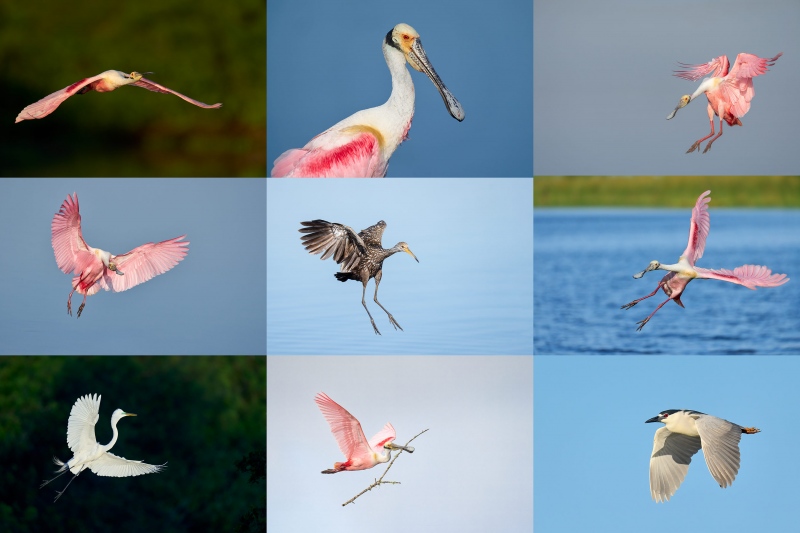

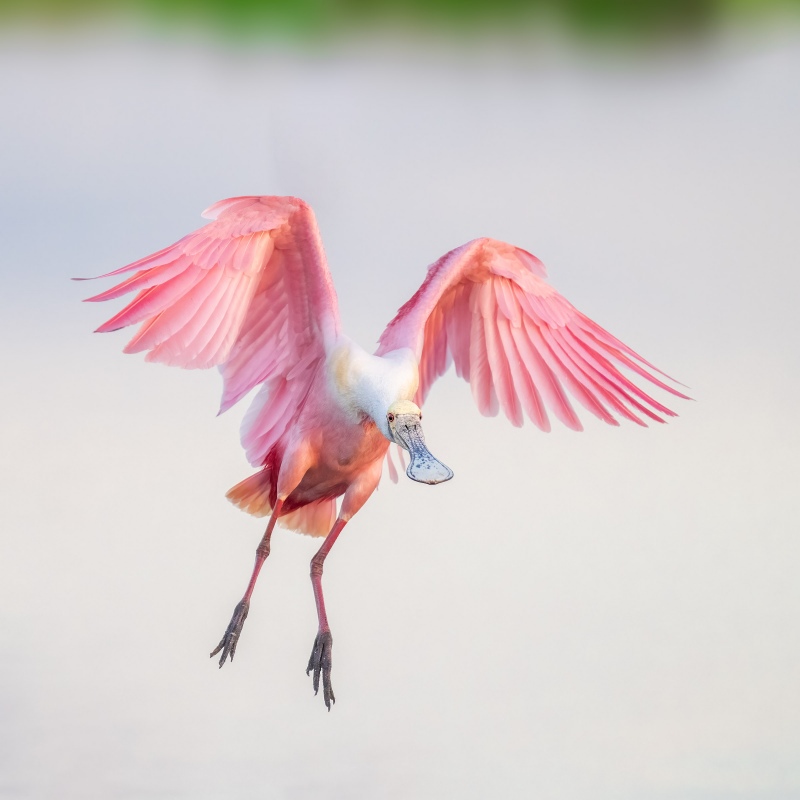
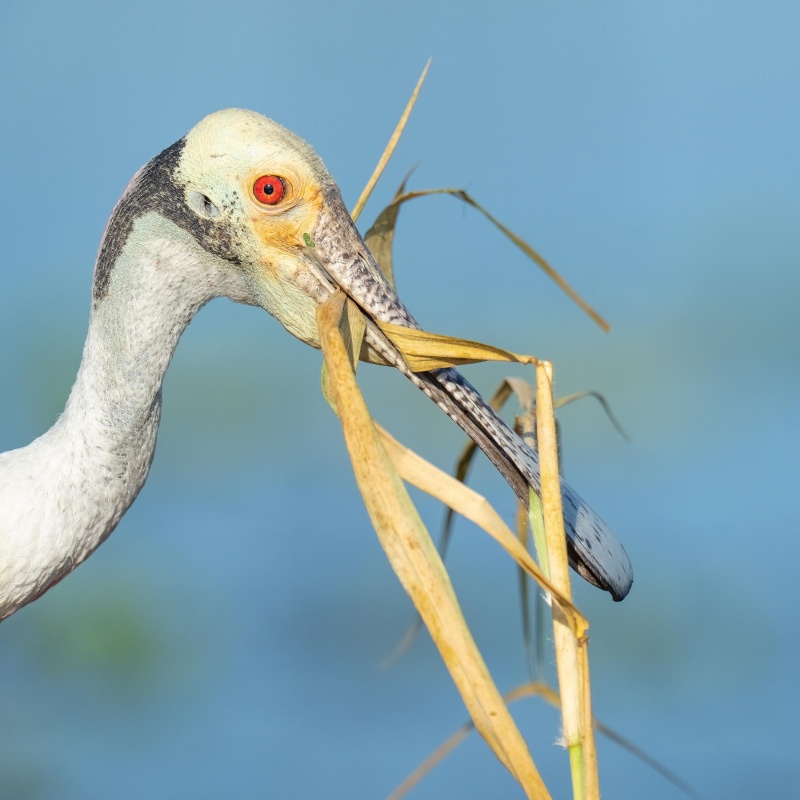
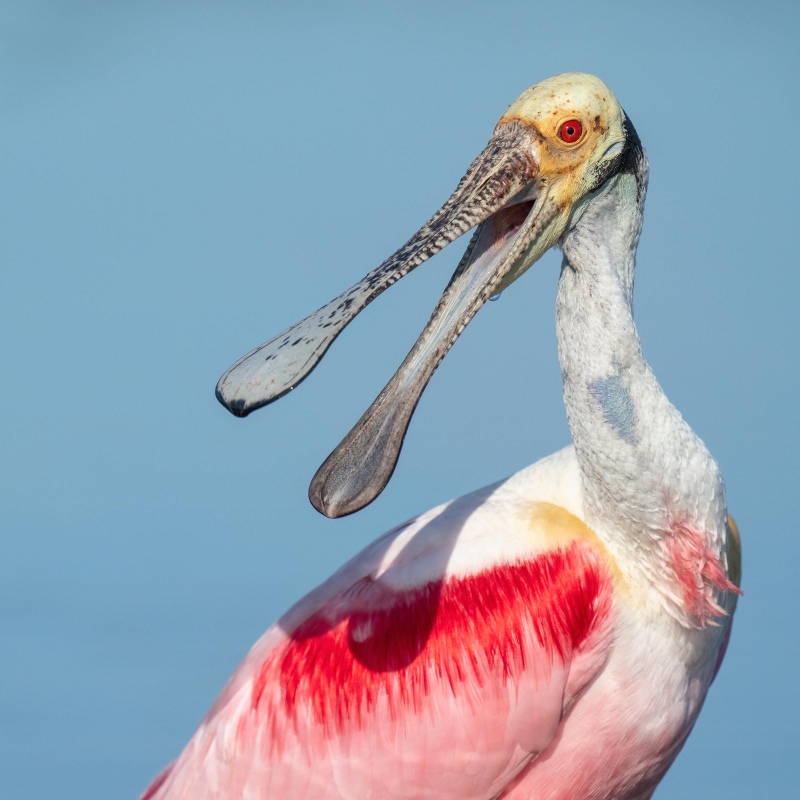
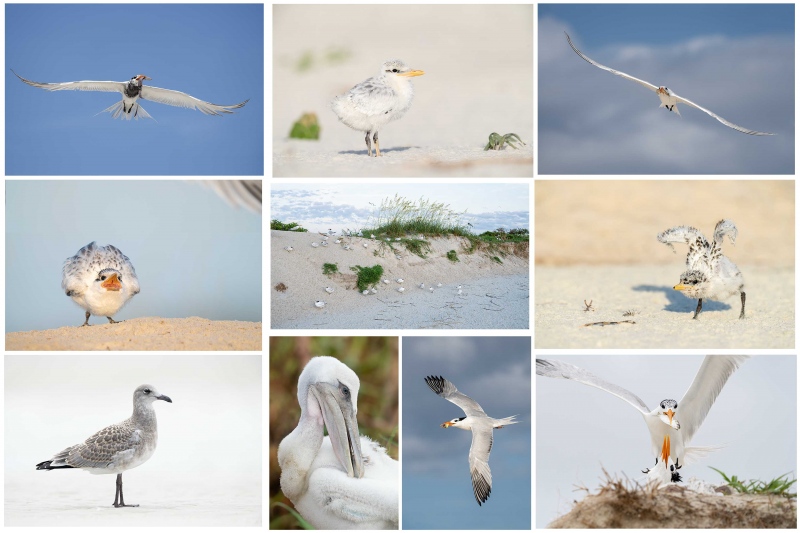













3 & 1. With 3 taking the cake. The talking “stork” is lit. A small shadow like the one on this spoonbill is inconsequential to me. Beauty and it’s not a BIF. Thanks for sharing.
Artie
I love all of the images however #3 takes it for me, i actually love the shadow on the back how it comes together the head turn and the call to it’s mate and it’s not often one can say they like the shadow, i think you also love the shadow.
Always with love b
#1 for me. I like the wing positions, the softish blurriness showing motion, the really sharp head and feet and beautiful colors. #2 I wouldn’t hang on my wall but would be great in a magazine showing behavior. I think a single point autofocus might be best. Because you are so close to the bird that a wide AF sensor might catch the closest grass leaf which would leave the eye out of focus. #3 doesn’t work for me because of the bill shadows.
My favorite image of the Roseate Spoonbill is the third one, although, the second image could very well have been my top pick too. The first one is elegant, beautiful color but the last two show the bird engaged in some kind of behavior and I find that more interesting.
Art, three interesting shots but I’m going with #3 because of the wonderful detail in the image.